2010 JAGUAR XFR heater
[x] Cancel search: heaterPage 2129 of 3039

DTC Description Possible Causes Action B1163-15
Left Mirror Heater
Output Short To Power -
Circuit short to battery
or open
Short to power or open circuit
Refer to the electrical circuit diagrams and
test left mirror heater output circuit for short
to power or open circuit B1164-11
Right Mirror Heater
Output Short To Ground
- Circuit short to ground
Short to ground
Refer to the electrical circuit diagrams and
test right mirror heater output circuit for
short to ground B1164-15
Right Mirror Heater
Output Short To Power -
Circuit short to battery
or open
Short to power or open circuit
Refer to the electrical circuit diagrams and
test right mirror heater output circuit for
short to power or open circuit B1165-11
Left Front Puddle Lamp
Output Short To Ground
- Circuit short to ground
Short to ground
Refer to the electrical circuit diagrams and
test left front puddle lamp output circuit for
short to ground B1165-15
Left Front Puddle Lamp
Output Open Load Or
Short To Power - Circuit
short to battery or open
Short to power or open circuit
Refer to the electrical circuit diagrams and
test left front puddle lamp output circuit for
short to power or open circuit B1166-11
Right Front Puddle Lamp
Output Short To Ground
- Circuit short to ground
Short to ground
Refer to the electrical circuit diagrams and
test right front puddle lamp output circuit
for short to ground B1166-15
Right Front Puddle Lamp
Output Open Load Or
Short To Battery -
Circuit short to battery
or open
Short to power or open circuit
Refer to the electrical circuit diagrams and
test right front puddle lamp output circuit
for short to power or open circuit B1175-13
Driver Door Ajar Switch -
Circuit open
Driver door ajar switch signal
circuit - open circuit
Refer to the electrical circuit diagrams and
check driver door ajar switch signal circuit
for open circuit B1176-13
Passenger Door Ajar
Switch - Circuit open
Passenger door ajar switch
signal circuit - open circuit
Refer to the electrical circuit diagrams and
check passenger door ajar switch signal
circuit for open circuit B117C-07
Rear Power Window Up -
Mechanical failures
Set when window is reversed
during window up due to
mechanical problems, window
channel restriction preventing
window closure or Window
mechanism fault
Check for mechanical problems with the
window operation. Check for obstructions in
the window channels and that the glass is
not restricted in the full range of travel B117C-72
Rear Power Window Up -
Actuator stuck open
Door module internal relay
sticking open
Renew the relevant rear door module. Refer
to the warranty policy and procedures
manual if a module is suspect B117C-73
Rear Power Window Up -
Actuator stuck closed
Door module internal relay
sticking closed
Renew the relevant rear door module. Refer
to the warranty policy and procedures
manual if a module is suspect B117C-92
Rear Power Window Up -
Performance or incorrect
operation
Set when auto window up was
interrupted (e.g. by pressing
local switch)
Check the window operation. Clear the DTC
and retest B117D-72
Rear Power Window
Down - Actuator stuck
open
Door module internal relay
sticking open
Renew the relevant rear door module. Refer
to the warranty policy and procedures
manual if a module is suspect B117D-73
Rear Power Window
Down - Actuator stuck
closed
Door module internal relay
sticking closed
Renew the relevant rear door module. Refer
to the warranty policy and procedures
manual if a module is suspect
Page 2131 of 3039

DTC Description Possible Causes Action security. Clear the DTC and retest. If the
problem persists, renew the driver door
window switch B11F6-11
Driver Folding Mirror
Motor - Circuit short to
ground
Driver folding mirror motor
circuit short circuit to ground
Mirror motor failure
Refer to the electrical circuit diagrams and
check the mirror fold circuit between the
drivers door module and the mirror
assembly. Repair as necessary B11F6-15
Driver Folding Mirror
Motor - Circuit short to
battery or open
Driver mirror heater output
circuit short circuit to power or
open circuit
Mirror motor failure
Refer to the electrical circuit diagrams and
check the mirror fold circuit between the
drivers door module and the mirror
assembly. Repair as necessary B11F7-11
Passenger Folding Mirror
Motor - Circuit short to
ground
Passenger folding mirror motor
circuit short circuit to ground
Mirror motor failure
Refer to the electrical circuit diagrams and
check the mirror fold circuit between the
passenger door module and the mirror
assembly. Repair as necessary B11F7-15
Passenger Folding Mirror
Motor - Circuit short to
battery or open
Passenger mirror heater output
circuit short circuit to power or
open circuit
Mirror motor failure
Refer to the electrical circuit diagrams and
check the mirror fold circuit between the
passenger door module and the mirror
assembly. Repair as necessary B1222-23
Master Lock/Unlock
Switch - Signal stuck
low
Master lock or unlock switch
digital input circuit - signal
stuck low
Refer to the electrical circuit diagrams and
check master lock and unlock switch digital
input circuits for short to ground, open
circuit B1A98-83
LIN Bus Circuit #1 -
Value of signal
protection calculation
incorrect
Value of signal protection
calculation incorrect
Refer to the electrical circuit diagrams and
check the LIN Bus circuit between the rear
door control unit and the Driver Door
Module. Check the connectors for integrity
and security. Clear the DTC and retest. If
the problem persists, renew the rear door
control module B1A98-86
LIN Bus Circuit #1 -
Signal invalid
Signal invalid
Refer to the electrical circuit diagrams and
check the LIN Bus circuit between the rear
door control unit and the Driver Door
Module. Check the connectors for integrity
and security. Clear the DTC and retest. If
the problem persists, renew the rear door
control module B1A98-87
LIN Bus Circuit #1 -
Missing message
Missing message
Refer to the electrical circuit diagrams and
check the LIN Bus circuit between the rear
door control unit and the Driver Door
Module. Check the connectors for integrity
and security. Clear the DTC and retest. If
the problem persists, renew the rear door
control module B1C09-11
Driver Left/Right Mirror
Motor Circuit - Circuit
short to ground
Driver mirror adjustment motor
circuit short circuit to ground
Mirror left/right motor failure
Refer to the electrical circuit diagrams and
check the mirror motor circuit between the
drivers door module and the mirror
assembly. Repair as necessary B1C09-15
Driver Left/Right Mirror
Motor Circuit - Circuit
short to battery or open
Driver mirror adjustment motor
circuit short circuit to power or
open circuit
Mirror left/right motor failure
Refer to the electrical circuit diagrams and
check the mirror motor circuit between the
drivers door module and the mirror
assembly. Repair as necessary B1C10-11
Driver Up/Down Mirror
Motor Circuit - Circuit
short to ground
Driver mirror adjustment motor
circuit short circuit to ground
Mirror motor failure
Refer to the electrical circuit diagrams and
check the mirror motor circuit between the
drivers door module and the mirror
assembly. Repair as necessary
Page 2164 of 3039
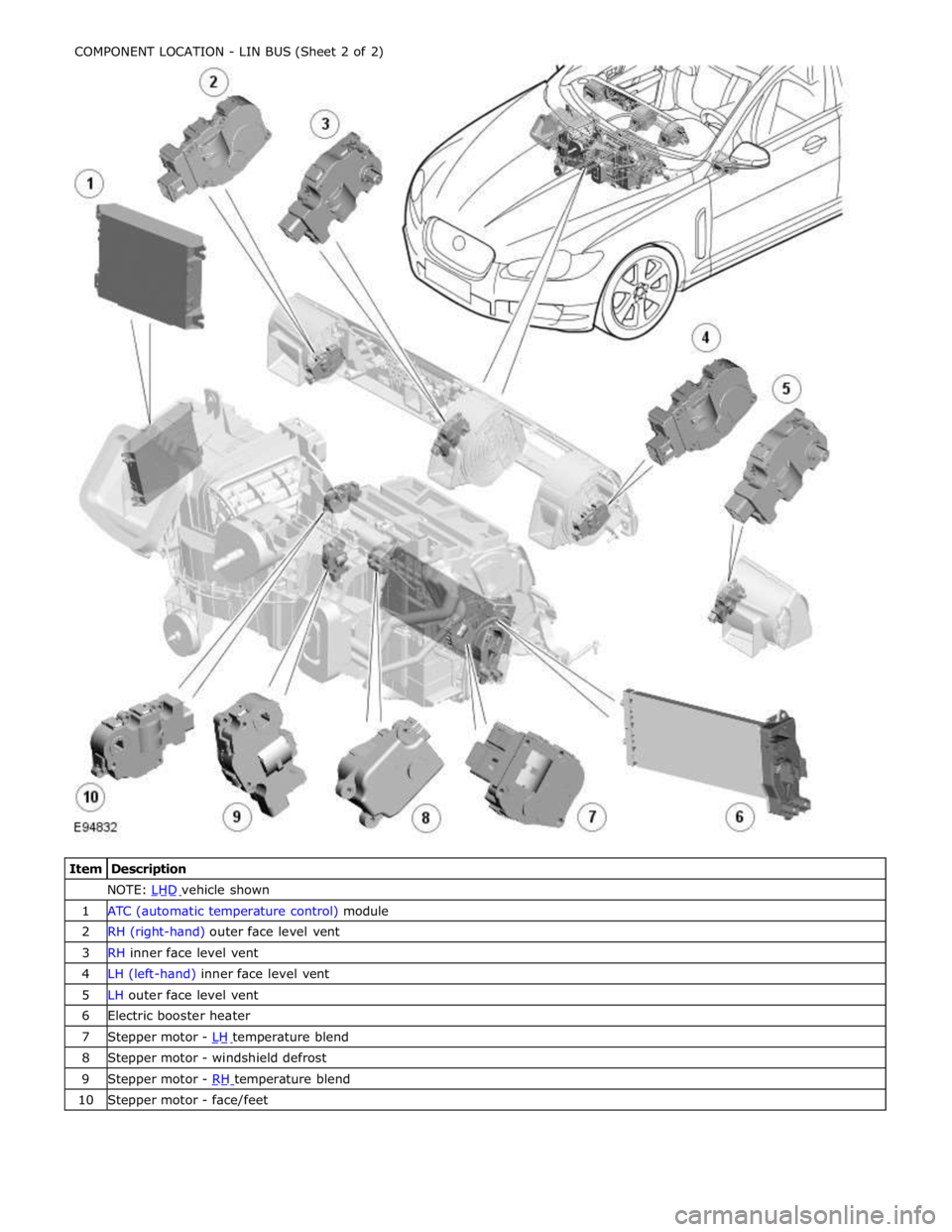
NOTE: LHD vehicle shown 1 ATC (automatic temperature control) module 2 RH (right-hand) outer face level vent 3 RH inner face level vent 4 LH (left-hand) inner face level vent 5 LH outer face level vent 6 Electric booster heater 7 Stepper motor - LH temperature blend 8 Stepper motor - windshield defrost 9 Stepper motor - RH temperature blend 10 Stepper motor - face/feet COMPONENT LOCATION - LIN BUS (Sheet 2 of 2)
Page 2171 of 3039
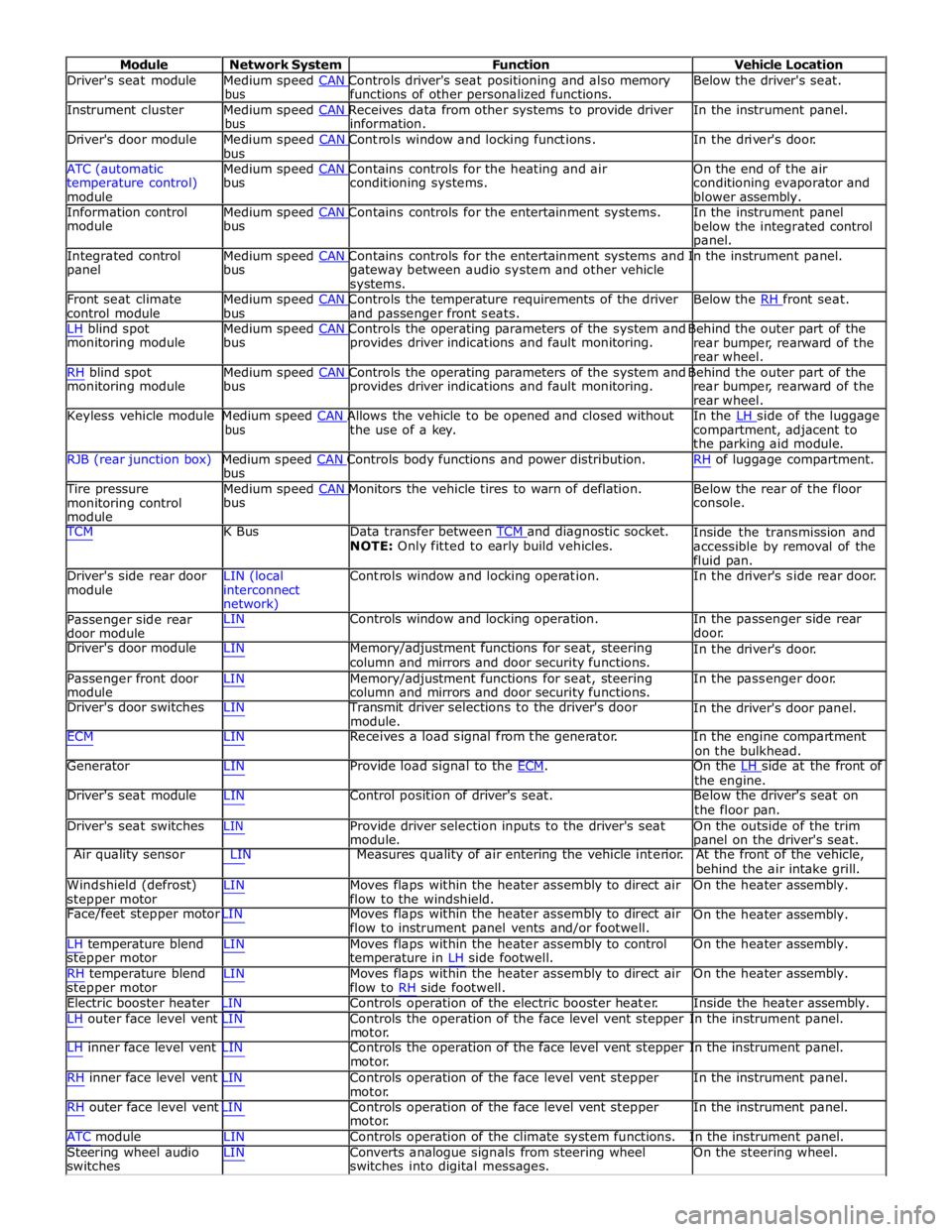
Module Network System Function Vehicle Location
Driver's seat module Medium speed CAN Controls driver's seat positioning and also memory Below the driver's seat. bus functions of other personalized functions.
Instrument cluster Medium speed CAN Receives data from other systems to provide driver In the instrument panel. bus information.
Driver's door module Medium speed CAN Controls window and locking functions. In the driver's door. bus
ATC (automatic Medium speed CAN Contains controls for the heating and air On the end of the air
temperature control)
module bus conditioning systems.
conditioning evaporator and
blower assembly.
Information control Medium speed CAN Contains controls for the entertainment systems. In the instrument panel module bus
below the integrated control
panel.
Integrated control Medium speed CAN Contains controls for the entertainment systems and In the instrument panel. panel bus
gateway between audio system and other vehicle
systems.
Front seat climate Medium speed CAN Controls the temperature requirements of the driver Below the RH front seat. control module bus and passenger front seats.
LH blind spot Medium speed CAN Controls the operating parameters of the system and Behind the outer part of the monitoring module bus provides driver indications and fault monitoring.
rear bumper, rearward of the
rear wheel.
RH blind spot Medium speed CAN Controls the operating parameters of the system and Behind the outer part of the monitoring module bus provides driver indications and fault monitoring.
rear bumper, rearward of the
rear wheel.
Keyless vehicle module Medium speed CAN Allows the vehicle to be opened and closed without In the LH side of the luggage bus the use of a key.
compartment, adjacent to
the parking aid module.
RJB (rear junction box) Medium speed CAN Controls body functions and power distribution. RH of luggage compartment. bus
Tire pressure Medium speed CAN Monitors the vehicle tires to warn of deflation. Below the rear of the floor monitoring control
module bus console.
TCM K Bus Data transfer between TCM and diagnostic socket. NOTE: Only fitted to early build vehicles. Inside the transmission and
accessible by removal of the
fluid pan.
Driver's side rear door
module LIN (local
interconnect
network) Controls window and locking operation. In the driver's side rear door.
Passenger side rear
door module LIN Controls window and locking operation. In the passenger side rear
door.
Driver's door module LIN Memory/adjustment functions for seat, steering
column and mirrors and door security functions. In the driver's door.
Passenger front door
module LIN Memory/adjustment functions for seat, steering
column and mirrors and door security functions. In the passenger door.
Driver's door switches LIN Transmit driver selections to the driver's door
module. In the driver's door panel.
ECM LIN Receives a load signal from the generator. In the engine compartment
on the bulkhead.
Generator LIN Provide load signal to the ECM. On the LH side at the front of the engine.
Driver's seat module LIN Control position of driver's seat. Below the driver's seat on
the floor pan.
Driver's seat switches LIN Provide driver selection inputs to the driver's seat
module. On the outside of the trim
panel on the driver's seat.
Air quality sensor LIN Measures quality of air entering the vehicle interior. At the front of the vehicle,
behind the air intake grill.
Windshield (defrost)
stepper motor LIN Moves flaps within the heater assembly to direct air
flow to the windshield. On the heater assembly.
Face/feet stepper motor LIN Moves flaps within the heater assembly to direct air
flow to instrument panel vents and/or footwell. On the heater assembly.
LH temperature blend
stepper motor
RH temperature blend
stepper motor LIN Moves flaps within the heater assembly to control
temperature in LH side footwell.
LIN Moves flaps within the heater assembly to direct air
flow to RH side footwell. On the heater assembly.
On the heater assembly.
Electric booster heater LIN Controls operation of the electric booster heater. Inside the heater assembly.
LH outer face level vent LIN Controls the operation of the face level vent stepper In the instrument panel.
motor.
LH inner face level vent LIN Controls the operation of the face level vent stepper In the instrument panel.
motor.
RH inner face level vent LIN Controls operation of the face level vent stepper
motor.
RH outer face level vent LIN Controls operation of the face level vent stepper
motor. In the instrument panel.
In the instrument panel.
ATC module LIN Controls operation of the climate system functions. In the instrument panel.
Steering wheel audio
switches LIN Converts analogue signals from steering wheel
switches into digital messages. On the steering wheel.
Page 2174 of 3039
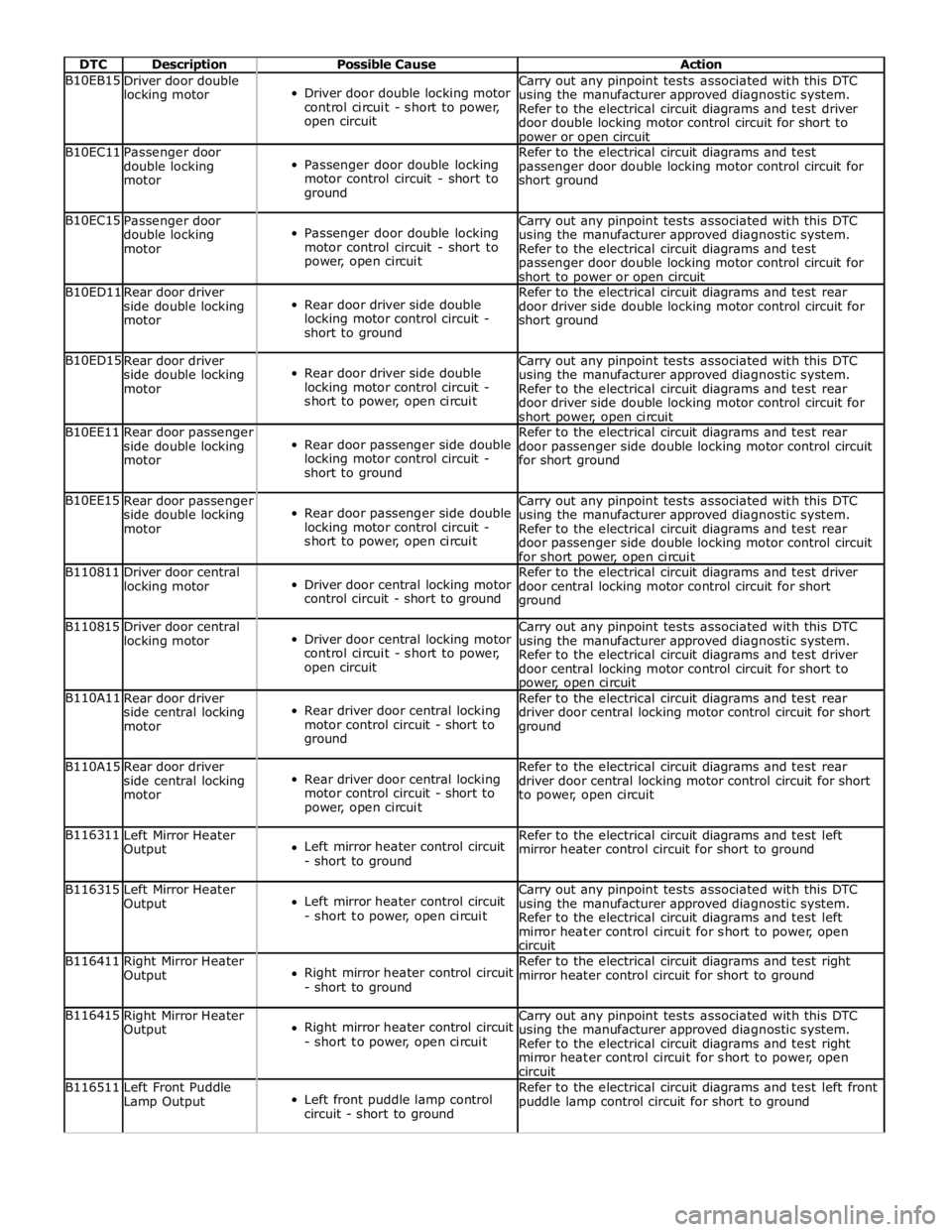
DTC Description Possible Cause Action B10EB15
Driver door double
locking motor
Driver door double locking motor
control circuit - short to power,
open circuit Carry out any pinpoint tests associated with this DTC
using the manufacturer approved diagnostic system.
Refer to the electrical circuit diagrams and test driver
door double locking motor control circuit for short to power or open circuit B10EC11
Passenger door
double locking
motor
Passenger door double locking
motor control circuit - short to
ground Refer to the electrical circuit diagrams and test
passenger door double locking motor control circuit for
short ground B10EC15
Passenger door
double locking
motor
Passenger door double locking
motor control circuit - short to
power, open circuit Carry out any pinpoint tests associated with this DTC
using the manufacturer approved diagnostic system.
Refer to the electrical circuit diagrams and test
passenger door double locking motor control circuit for
short to power or open circuit B10ED11
Rear door driver
side double locking
motor
Rear door driver side double
locking motor control circuit -
short to ground Refer to the electrical circuit diagrams and test rear
door driver side double locking motor control circuit for
short ground B10ED15
Rear door driver
side double locking
motor
Rear door driver side double
locking motor control circuit -
short to power, open circuit Carry out any pinpoint tests associated with this DTC
using the manufacturer approved diagnostic system.
Refer to the electrical circuit diagrams and test rear
door driver side double locking motor control circuit for
short power, open circuit B10EE11
Rear door passenger
side double locking
motor
Rear door passenger side double
locking motor control circuit -
short to ground Refer to the electrical circuit diagrams and test rear
door passenger side double locking motor control circuit
for short ground B10EE15
Rear door passenger
side double locking
motor
Rear door passenger side double
locking motor control circuit -
short to power, open circuit Carry out any pinpoint tests associated with this DTC
using the manufacturer approved diagnostic system.
Refer to the electrical circuit diagrams and test rear
door passenger side double locking motor control circuit
for short power, open circuit B110811
Driver door central
locking motor
Driver door central locking motor
control circuit - short to ground Refer to the electrical circuit diagrams and test driver
door central locking motor control circuit for short
ground B110815
Driver door central
locking motor
Driver door central locking motor
control circuit - short to power,
open circuit Carry out any pinpoint tests associated with this DTC
using the manufacturer approved diagnostic system.
Refer to the electrical circuit diagrams and test driver
door central locking motor control circuit for short to power, open circuit B110A11
Rear door driver
side central locking
motor
Rear driver door central locking
motor control circuit - short to
ground Refer to the electrical circuit diagrams and test rear
driver door central locking motor control circuit for short
ground B110A15
Rear door driver
side central locking
motor
Rear driver door central locking
motor control circuit - short to
power, open circuit Refer to the electrical circuit diagrams and test rear
driver door central locking motor control circuit for short
to power, open circuit B116311
Left Mirror Heater
Output
Left mirror heater control circuit
- short to ground Refer to the electrical circuit diagrams and test left
mirror heater control circuit for short to ground B116315
Left Mirror Heater
Output
Left mirror heater control circuit
- short to power, open circuit Carry out any pinpoint tests associated with this DTC
using the manufacturer approved diagnostic system.
Refer to the electrical circuit diagrams and test left
mirror heater control circuit for short to power, open
circuit B116411
Right Mirror Heater
Output
Right mirror heater control circuit
- short to ground Refer to the electrical circuit diagrams and test right
mirror heater control circuit for short to ground B116415
Right Mirror Heater
Output
Right mirror heater control circuit
- short to power, open circuit Carry out any pinpoint tests associated with this DTC
using the manufacturer approved diagnostic system.
Refer to the electrical circuit diagrams and test right
mirror heater control circuit for short to power, open
circuit B116511
Left Front Puddle
Lamp Output
Left front puddle lamp control
circuit - short to ground Refer to the electrical circuit diagrams and test left front
puddle lamp control circuit for short to ground
Page 2183 of 3039

DTC Description Possible Cause Action B10EB15
Driver door double
locking motor
Driver door double locking motor
control circuit - short to power,
open circuit Carry out any pinpoint tests associated with this DTC
using the manufacturer approved diagnostic system.
Refer to the electrical circuit diagrams and test driver
door double locking motor control circuit for short to power or open circuit B10EC11
Passenger door
double locking
motor
Passenger door double locking
motor control circuit - short to
ground Refer to the electrical circuit diagrams and test
passenger door double locking motor control circuit for
short ground B10EC15
Passenger door
double locking
motor
Passenger door double locking
motor control circuit - short to
power, open circuit Carry out any pinpoint tests associated with this DTC
using the manufacturer approved diagnostic system.
Refer to the electrical circuit diagrams and test
passenger door double locking motor control circuit for
short to power or open circuit B10ED11
Rear door driver side
double locking
motor
Rear door driver side double
locking motor control circuit -
short to ground Refer to the electrical circuit diagrams and test rear
door driver side double locking motor control circuit for
short ground B10ED15
Rear door driver side
double locking
motor
Rear door driver side double
locking motor control circuit -
short to power, open circuit Carry out any pinpoint tests associated with this DTC
using the manufacturer approved diagnostic system.
Refer to the electrical circuit diagrams and test rear
door driver side double locking motor control circuit for
short power, open circuit B10EE11
Rear door passenger
side double locking
motor
Rear door passenger side double
locking motor control circuit -
short to ground Refer to the electrical circuit diagrams and test rear
door passenger side double locking motor control circuit
for short ground B10EE15
Rear door passenger
side double locking
motor
Rear door passenger side double
locking motor control circuit -
short to power, open circuit Carry out any pinpoint tests associated with this DTC
using the manufacturer approved diagnostic system.
Refer to the electrical circuit diagrams and test rear
door passenger side double locking motor control circuit
for short power, open circuit B110911
Passenger door
central locking
motor
Passenger door central locking
motor control circuit - short to
ground Refer to the electrical circuit diagrams and test
passenger door central locking motor control circuit for
short ground B110915
Passenger door
central locking
motor
Passenger door central locking
motor control circuit - short to
power, open circuit Refer to the electrical circuit diagrams and test
passenger door central locking motor control circuit for
short to power, open circuit B110B11
Rear door passenger
side central locking
motor
Rear passenger door central
locking motor control circuit -
short to ground Refer to the electrical circuit diagrams and test rear
passenger door central locking motor control circuit for
short ground B110B15
Rear door passenger
side central locking
motor
Rear passenger door central
locking motor control circuit -
short to power, open circuit Refer to the electrical circuit diagrams and test rear
passenger door central locking motor control circuit for
short to power, open circuit B116311
Left Mirror Heater
Output
Left mirror heater control circuit
- short to ground Refer to the electrical circuit diagrams and test left
mirror heater control circuit for short to ground B116315
Left Mirror Heater
Output
Left mirror heater control circuit
- short to power, open circuit Carry out any pinpoint tests associated with this DTC
using the manufacturer approved diagnostic system.
Refer to the electrical circuit diagrams and test left
mirror heater control circuit for short to power, open
circuit B116411
Right Mirror Heater
Output
Right mirror heater control circuit
- short to ground Refer to the electrical circuit diagrams and test right
mirror heater control circuit for short to ground B116415
Right Mirror Heater
Output
Right mirror heater control circuit
- short to power, open circuit Carry out any pinpoint tests associated with this DTC
using the manufacturer approved diagnostic system.
Refer to the electrical circuit diagrams and test right
mirror heater control circuit for short to power, open
circuit B116511
Left Front Puddle
Lamp Output
Left front puddle lamp control
circuit - short to ground Refer to the electrical circuit diagrams and test left front
puddle lamp control circuit for short to ground
Page 2294 of 3039
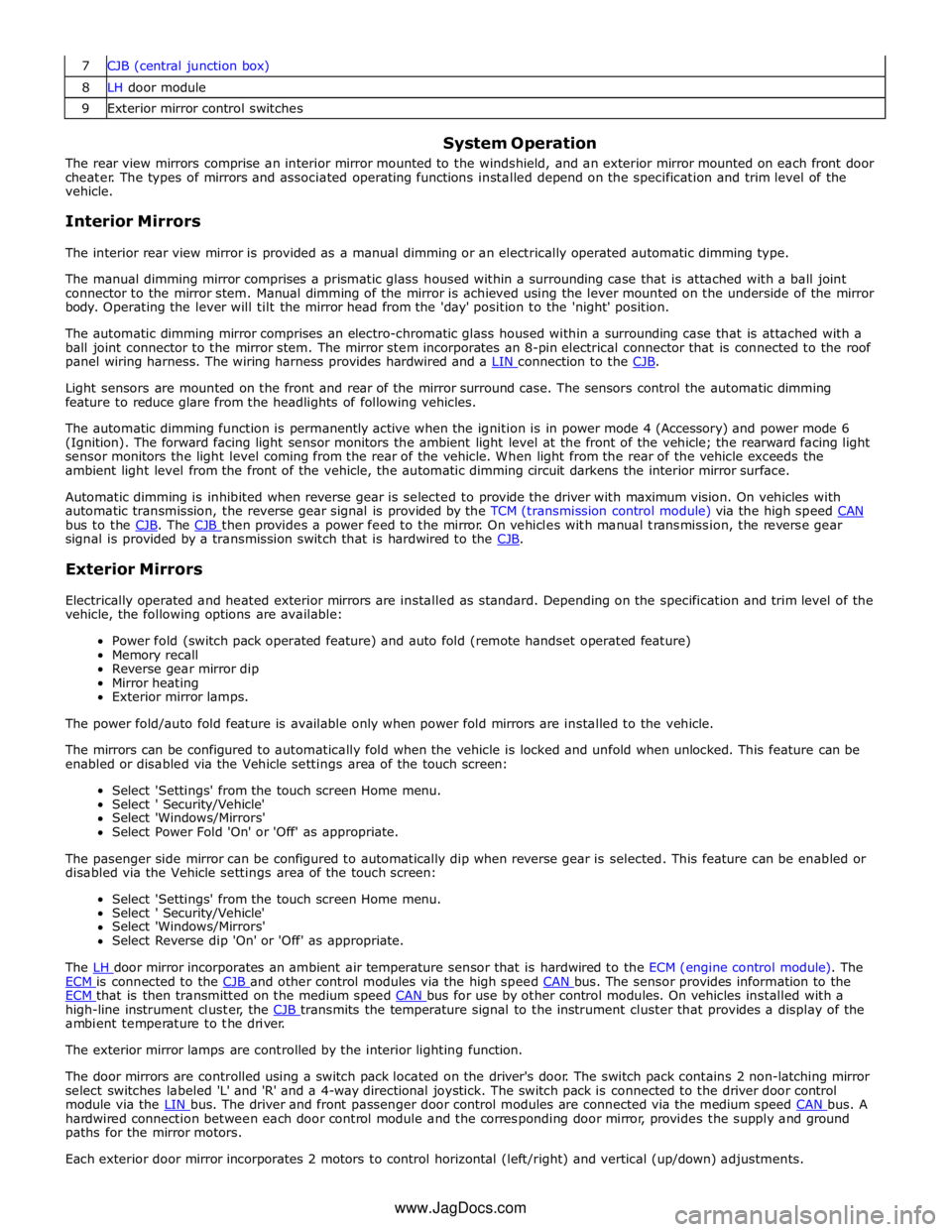
8 LH door module 9 Exterior mirror control switches
System Operation
The rear view mirrors comprise an interior mirror mounted to the windshield, and an exterior mirror mounted on each front door
cheater. The types of mirrors and associated operating functions installed depend on the specification and trim level of the
vehicle.
Interior Mirrors
The interior rear view mirror is provided as a manual dimming or an electrically operated automatic dimming type.
The manual dimming mirror comprises a prismatic glass housed within a surrounding case that is attached with a ball joint
connector to the mirror stem. Manual dimming of the mirror is achieved using the lever mounted on the underside of the mirror
body. Operating the lever will tilt the mirror head from the 'day' position to the 'night' position.
The automatic dimming mirror comprises an electro-chromatic glass housed within a surrounding case that is attached with a
ball joint connector to the mirror stem. The mirror stem incorporates an 8-pin electrical connector that is connected to the roof
panel wiring harness. The wiring harness provides hardwired and a LIN connection to the CJB.
Light sensors are mounted on the front and rear of the mirror surround case. The sensors control the automatic dimming
feature to reduce glare from the headlights of following vehicles.
The automatic dimming function is permanently active when the ignition is in power mode 4 (Accessory) and power mode 6
(Ignition). The forward facing light sensor monitors the ambient light level at the front of the vehicle; the rearward facing light
sensor monitors the light level coming from the rear of the vehicle. When light from the rear of the vehicle exceeds the
ambient light level from the front of the vehicle, the automatic dimming circuit darkens the interior mirror surface.
Automatic dimming is inhibited when reverse gear is selected to provide the driver with maximum vision. On vehicles with
automatic transmission, the reverse gear signal is provided by the TCM (transmission control module) via the high speed CAN bus to the CJB. The CJB then provides a power feed to the mirror. On vehicles with manual transmission, the reverse gear signal is provided by a transmission switch that is hardwired to the CJB.
Exterior Mirrors
Electrically operated and heated exterior mirrors are installed as standard. Depending on the specification and trim level of the
vehicle, the following options are available:
Power fold (switch pack operated feature) and auto fold (remote handset operated feature)
Memory recall
Reverse gear mirror dip
Mirror heating
Exterior mirror lamps.
The power fold/auto fold feature is available only when power fold mirrors are installed to the vehicle.
The mirrors can be configured to automatically fold when the vehicle is locked and unfold when unlocked. This feature can be
enabled or disabled via the Vehicle settings area of the touch screen:
Select 'Settings' from the touch screen Home menu.
Select ' Security/Vehicle'
Select 'Windows/Mirrors'
Select Power Fold 'On' or 'Off' as appropriate.
The pasenger side mirror can be configured to automatically dip when reverse gear is selected. This feature can be enabled or
disabled via the Vehicle settings area of the touch screen:
Select 'Settings' from the touch screen Home menu.
Select ' Security/Vehicle'
Select 'Windows/Mirrors'
Select Reverse dip 'On' or 'Off' as appropriate.
The LH door mirror incorporates an ambient air temperature sensor that is hardwired to the ECM (engine control module). The ECM is connected to the CJB and other control modules via the high speed CAN bus. The sensor provides information to the ECM that is then transmitted on the medium speed CAN bus for use by other control modules. On vehicles installed with a high-line instrument cluster, the CJB transmits the temperature signal to the instrument cluster that provides a display of the ambient temperature to the driver.
The exterior mirror lamps are controlled by the interior lighting function.
The door mirrors are controlled using a switch pack located on the driver's door. The switch pack contains 2 non-latching mirror
select switches labeled 'L' and 'R' and a 4-way directional joystick. The switch pack is connected to the driver door control
module via the LIN bus. The driver and front passenger door control modules are connected via the medium speed CAN bus. A hardwired connection between each door control module and the corresponding door mirror, provides the supply and ground
paths for the mirror motors.
Each exterior door mirror incorporates 2 motors to control horizontal (left/right) and vertical (up/down) adjustments. www.JagDocs.com
Page 2295 of 3039
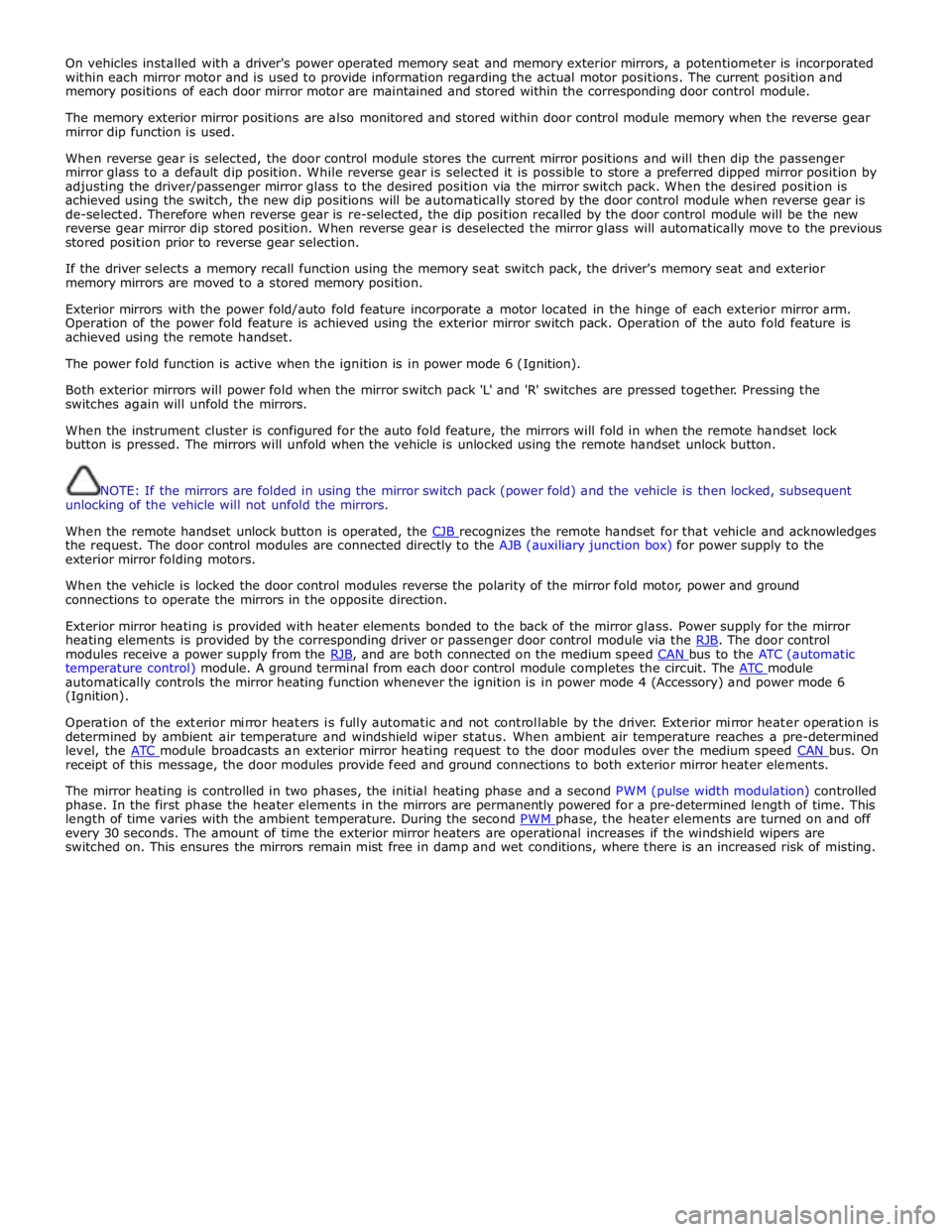
On vehicles installed with a driver's power operated memory seat and memory exterior mirrors, a potentiometer is incorporated
within each mirror motor and is used to provide information regarding the actual motor positions. The current position and
memory positions of each door mirror motor are maintained and stored within the corresponding door control module.
The memory exterior mirror positions are also monitored and stored within door control module memory when the reverse gear
mirror dip function is used.
When reverse gear is selected, the door control module stores the current mirror positions and will then dip the passenger
mirror glass to a default dip position. While reverse gear is selected it is possible to store a preferred dipped mirror position by
adjusting the driver/passenger mirror glass to the desired position via the mirror switch pack. When the desired position is
achieved using the switch, the new dip positions will be automatically stored by the door control module when reverse gear is
de-selected. Therefore when reverse gear is re-selected, the dip position recalled by the door control module will be the new
reverse gear mirror dip stored position. When reverse gear is deselected the mirror glass will automatically move to the previous
stored position prior to reverse gear selection.
If the driver selects a memory recall function using the memory seat switch pack, the driver's memory seat and exterior
memory mirrors are moved to a stored memory position.
Exterior mirrors with the power fold/auto fold feature incorporate a motor located in the hinge of each exterior mirror arm.
Operation of the power fold feature is achieved using the exterior mirror switch pack. Operation of the auto fold feature is
achieved using the remote handset.
The power fold function is active when the ignition is in power mode 6 (Ignition).
Both exterior mirrors will power fold when the mirror switch pack 'L' and 'R' switches are pressed together. Pressing the
switches again will unfold the mirrors.
When the instrument cluster is configured for the auto fold feature, the mirrors will fold in when the remote handset lock
button is pressed. The mirrors will unfold when the vehicle is unlocked using the remote handset unlock button.
NOTE: If the mirrors are folded in using the mirror switch pack (power fold) and the vehicle is then locked, subsequent
unlocking of the vehicle will not unfold the mirrors.
When the remote handset unlock button is operated, the CJB recognizes the remote handset for that vehicle and acknowledges the request. The door control modules are connected directly to the AJB (auxiliary junction box) for power supply to the
exterior mirror folding motors.
When the vehicle is locked the door control modules reverse the polarity of the mirror fold motor, power and ground
connections to operate the mirrors in the opposite direction.
Exterior mirror heating is provided with heater elements bonded to the back of the mirror glass. Power supply for the mirror
heating elements is provided by the corresponding driver or passenger door control module via the RJB. The door control modules receive a power supply from the RJB, and are both connected on the medium speed CAN bus to the ATC (automatic temperature control) module. A ground terminal from each door control module completes the circuit. The ATC module automatically controls the mirror heating function whenever the ignition is in power mode 4 (Accessory) and power mode 6
(Ignition).
Operation of the exterior mirror heaters is fully automatic and not controllable by the driver. Exterior mirror heater operation is
determined by ambient air temperature and windshield wiper status. When ambient air temperature reaches a pre-determined
level, the ATC module broadcasts an exterior mirror heating request to the door modules over the medium speed CAN bus. On receipt of this message, the door modules provide feed and ground connections to both exterior mirror heater elements.
The mirror heating is controlled in two phases, the initial heating phase and a second PWM (pulse width modulation) controlled
phase. In the first phase the heater elements in the mirrors are permanently powered for a pre-determined length of time. This
length of time varies with the ambient temperature. During the second PWM phase, the heater elements are turned on and off every 30 seconds. The amount of time the exterior mirror heaters are operational increases if the windshield wipers are
switched on. This ensures the mirrors remain mist free in damp and wet conditions, where there is an increased risk of misting.